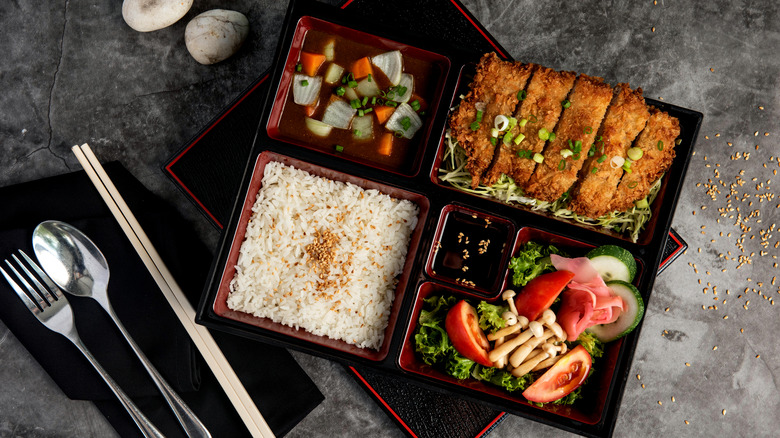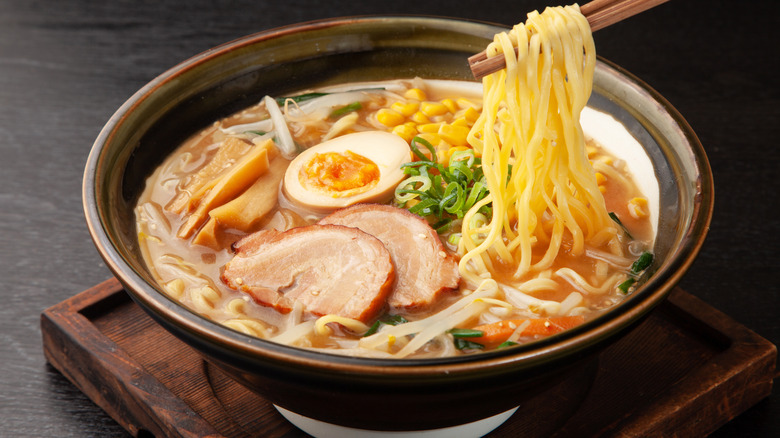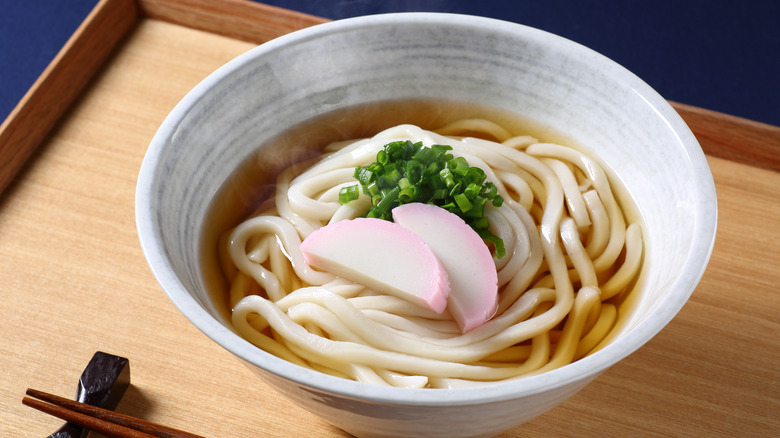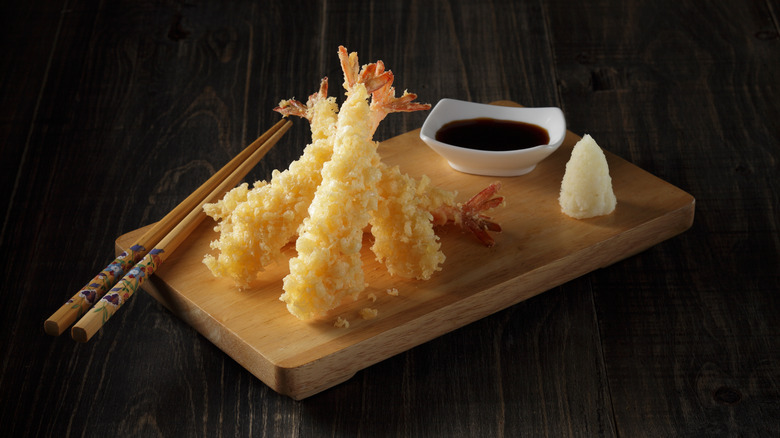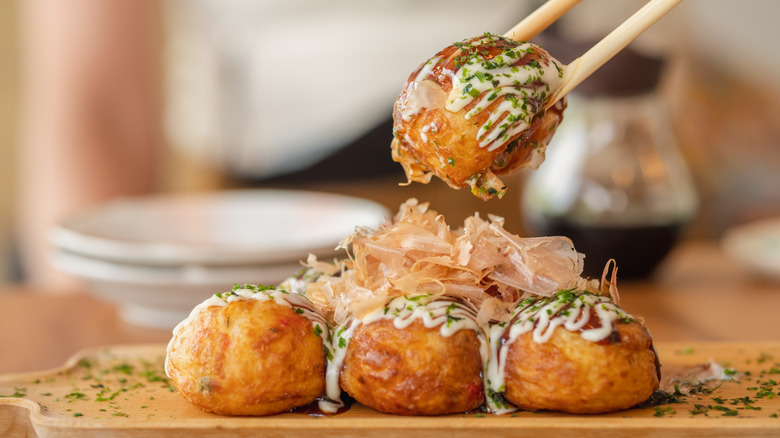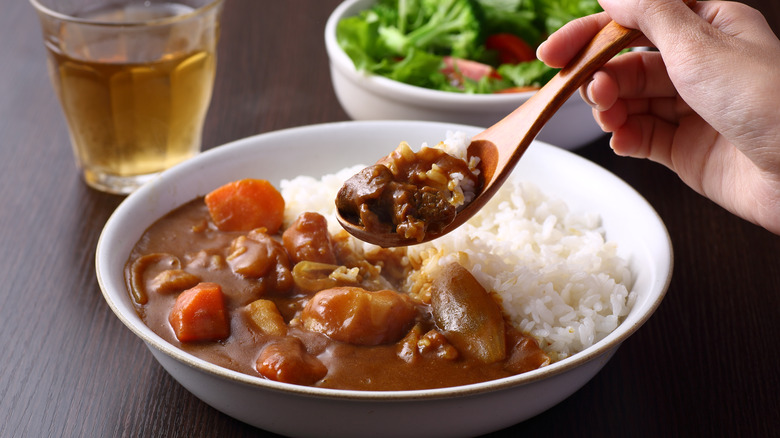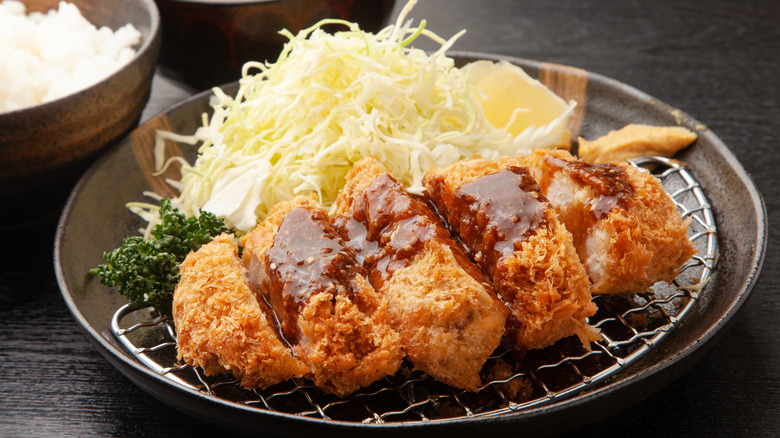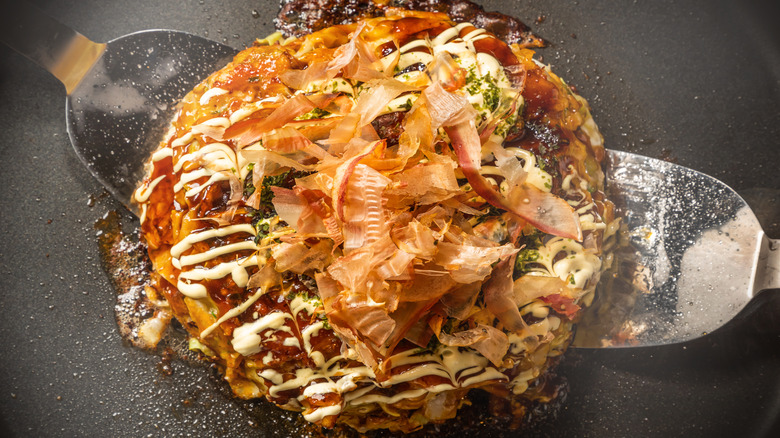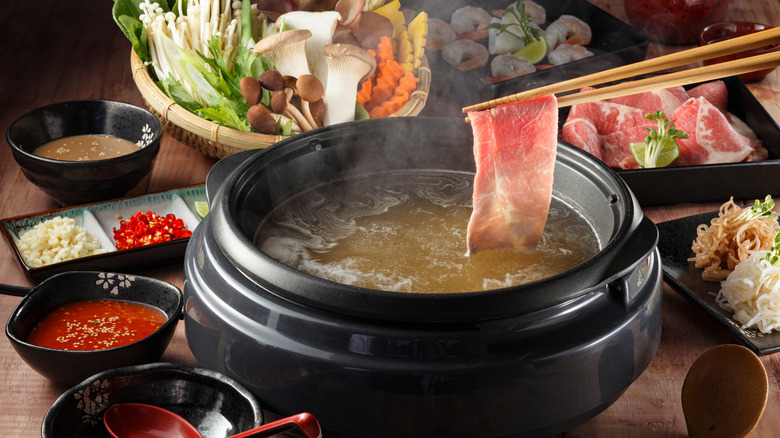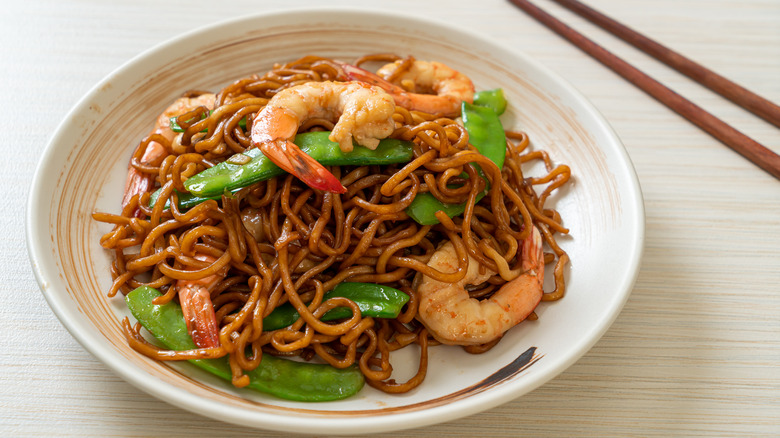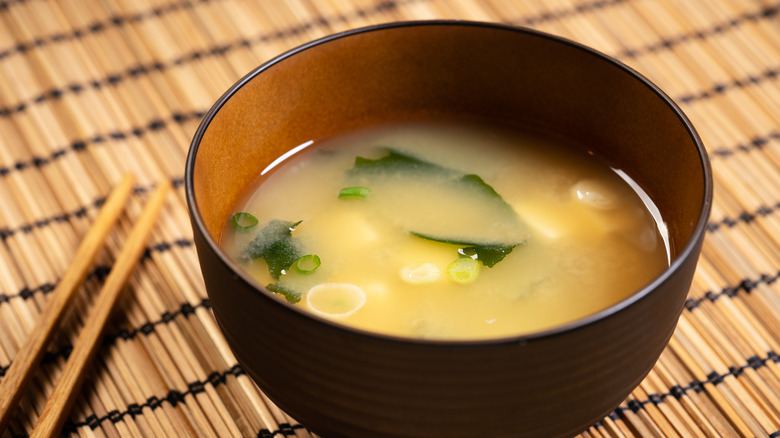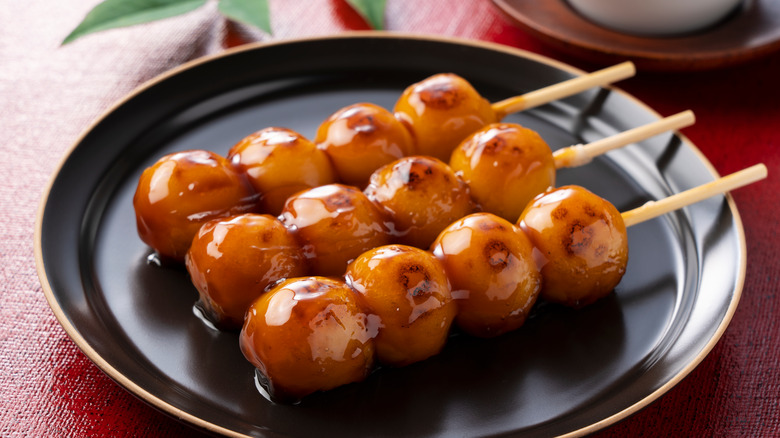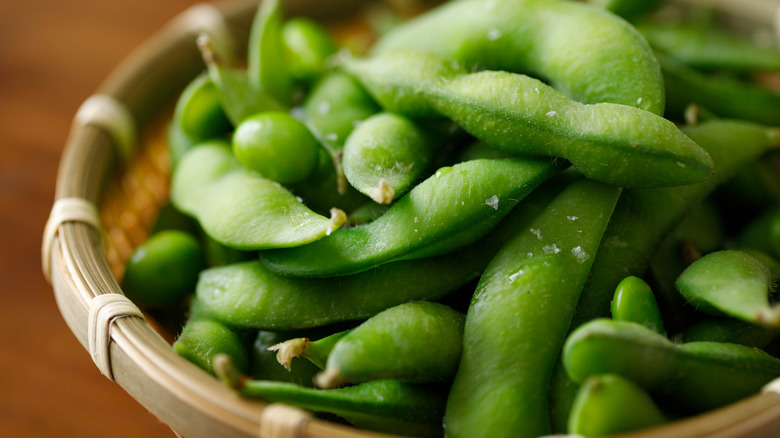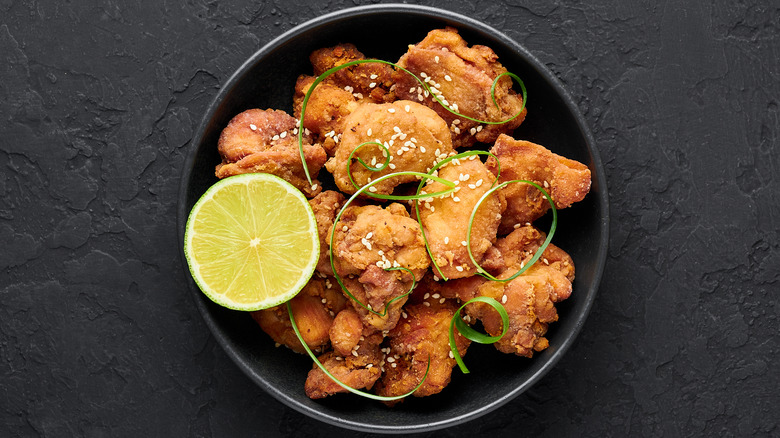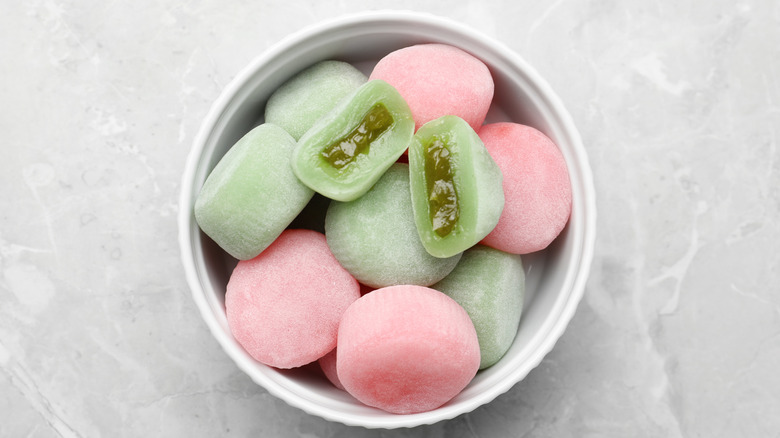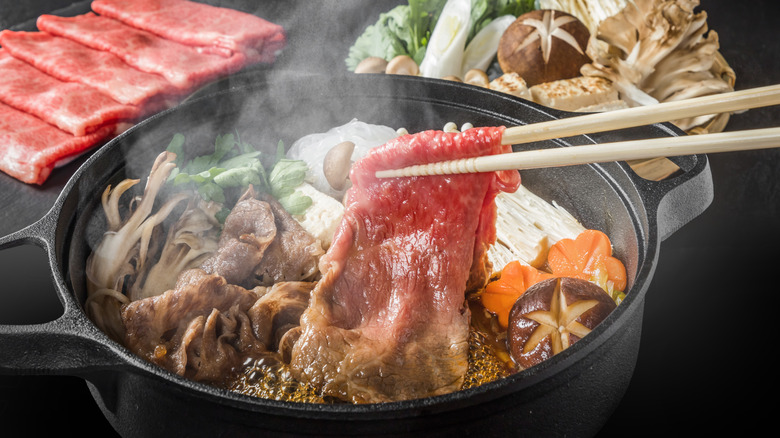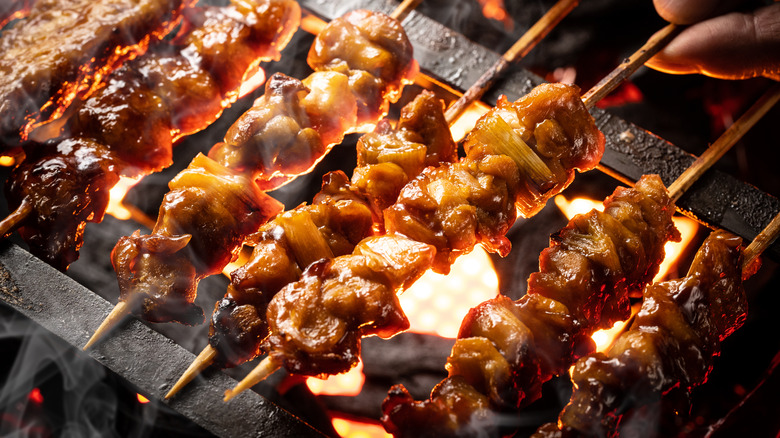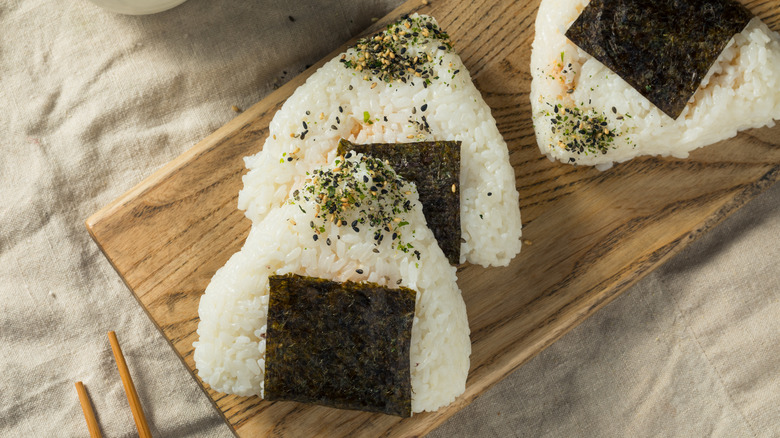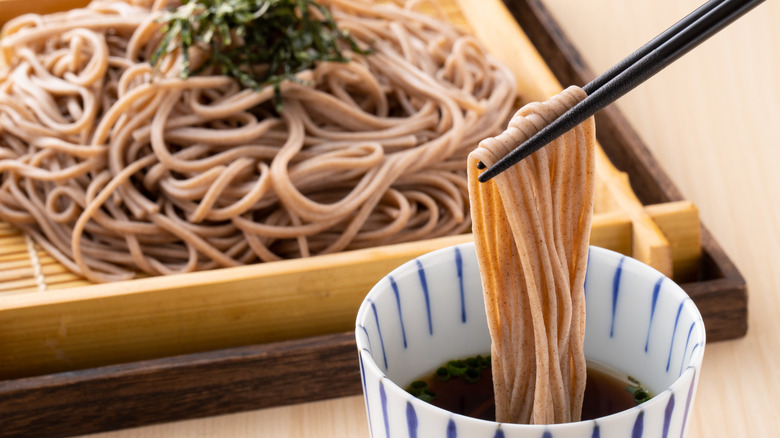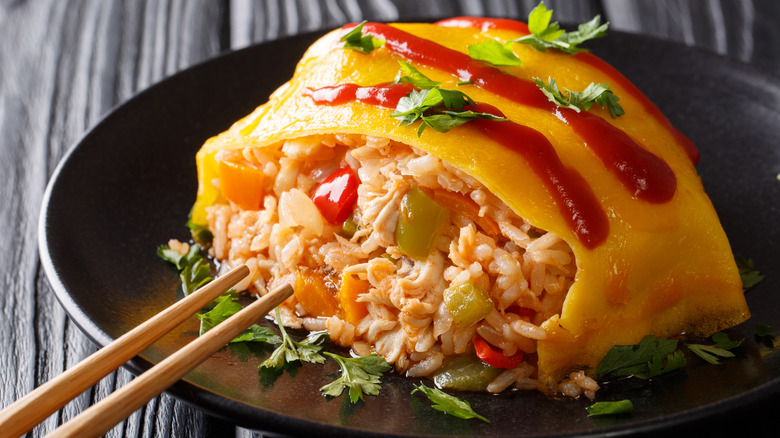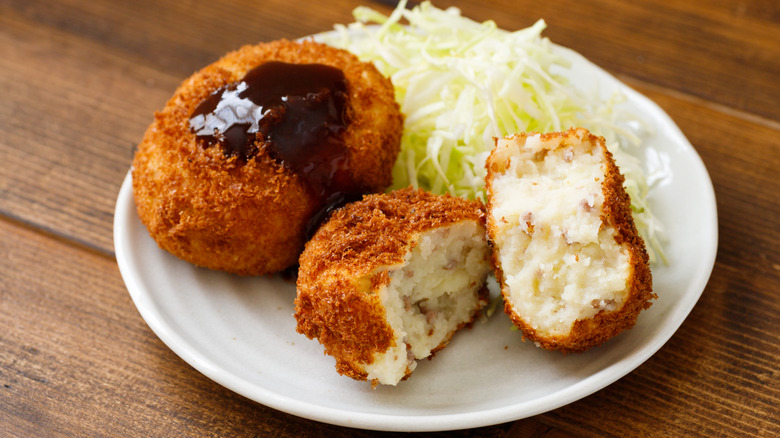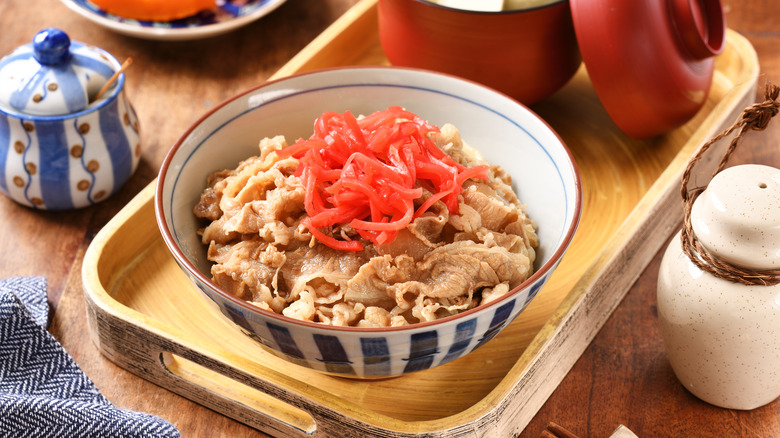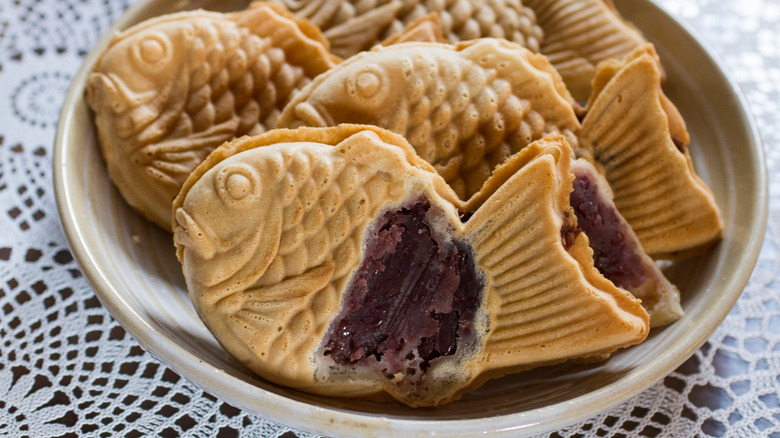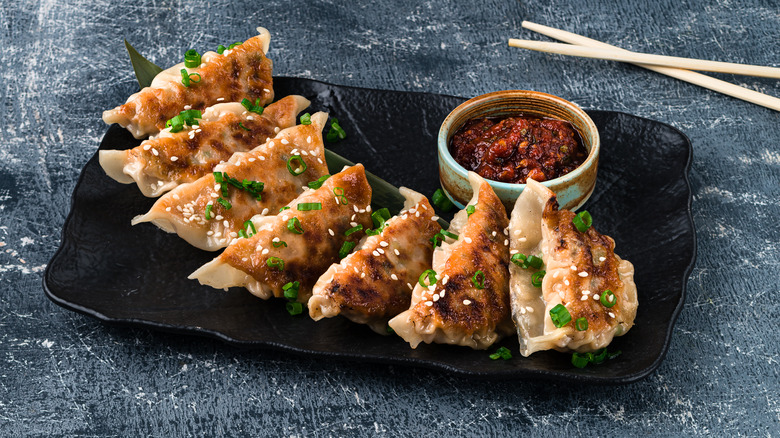The Best Japanese Food You Probably Haven't Tried Yet
Every country has at least one dish it's known for around the world. Canada has poutine — fries and cheese curds topped with gravy, Hungary has goulash — a heavily seasoned stew, and Spain has paella — saffron-seasoned rice filled with seafood. While many cultures have created a variety of delectable dishes, you'll be hard-pressed to find a country with more mouth-watering dishes than Japan.
While this Asian country is not always ranked with other foodie locations like Italy and France, Japan should not be disregarded by anyone who likes to eat. When visiting Japan, tourists don't have to worry about researching restaurants or reading online reviews because virtually every restaurant and bakery offers truly delicious food. You're probably familiar with a few of these dishes, including sushi, teriyaki chicken, and matcha. However, those are just the tip of the iceberg when it comes to Japanese dining. Here are some Japanese dishes you probably haven't tried yet, but definitely should.
Ramen
We're not talking about the instant stuff you eat out of a cup. While those soups have a special place in the hearts of college students everywhere, they can't compare to a true ramen experience. Like many Japanese dishes, ramen was inspired by Chinese cooking and tailored to create the unique bowl we know and love today.
Ramen is a soup consisting of wheat noodles served in a beef broth that is often flavored with soy sauce or miso (via The Spruce Eats). A traditional shoyu ramen is topped with pork or beef, green onion, and a soft-boiled egg. There are many variations of the soup containing different broths, proteins, and toppings. If you ever visit Japan, you'll find that every ramen shop makes its recipe a little differently by adding unique spices, vegetables, and other ingredients. Fortunately, you don't need to travel all the way to Japan to find an authentic version of this soup. Ramen shops are popping up all around the world due to the rising popularity of this flavor-packed dish.
Udon
Udon is a lesser-known but equally delicious Japanese soup, made with dashi stock that gives it a delectable umami flavor. The other hallmark ingredient of this soup is the udon noodles, which are thick, chewy, and made from wheat flour (via MasterClass). Udon soup is typically topped with green onions, although many variations include garnishes like fish cakes, shrimp tempura, and tofu. A spicy chili pepper seasoning called shichimi is often sprinkled on top.
Just like ramen, there are many takes on udon soup. Nabeyaki udon is filled with many ingredients, including tempura shrimp, fish cakes, chicken, and eggs, according to Taste Atlas. Meanwhile, curry udon contains Japanese curry mixed in with the noodles and broth. Different regions in Japan also have different udon variations, although you'll be able to find common ones like nabeyaki and curry udon, pretty much everywhere.
Udon can be harder to find in the United States than ramen, but it is fairly easy to make at home. You can find fresh and dried udon noodles at many supermarkets, and dashi broth powder at Asian grocery stores.
Tempura
Tempura is commonly labeled as a food but in fact, it simply indicates the method of cooking. Tempura batter is made by combining ice water, eggs, and wheat flour, with the occasional addition of baking soda or baking powder. Vegetables, meat, and seafood are then coated in the batter and deep-fried (via Gurunavi). The ice water prevents the gluten in the flour from being activated, and the remaining ingredients are mixed roughly to leave some lumps in the batter. This unique process makes a light, super crispy coating encasing the cooked ingredients.
Tempura can be eaten on its own with dipping sauce or as a part of other dishes. Some udon, soba, and rice dishes usually include a few tempura pieces on the side, Gurunavi explains. It has also become popular to find tempura inside sushi rolls. Tempura batter is sometimes mixed with shredded vegetables and shrimp before being cooked like a fritter. You can make this batter at home or purchase a mix that just requires extra water.
Takoyaki
A quintessential street food in Japan, takoyaki is often eaten at summer festivals in the country. Takoyaki are balls of fluffy dough that are cooked in a special pan and smothered in a savory sauce (via Tokyo Treat). More interestingly, each ball contains a small piece of grilled octopus in the center. Ginger, green onion, and bits of tempura are often added to the batter for flavor and texture. Apart from the sauce, takoyaki is often topped with Japanese mayonnaise and bonito flakes, which are paper-thin slices of skipjack tuna.
Although it is a popular street food, you can find takoyaki at many restaurants, shops, and even convenience stores in Japan. These balls are usually served piping hot, so be sure to give yours time to cool before you dig in. The recipe is fairly simple but it does require a special pan with half-spherical molds to create the snack's round shape. If you're eager to make your own, you can find takoyaki pans online or in many Asian supermarkets or home goods stores.
Curry Rice
Almost every South Asian country has its own version of curry. While comparing curries is like comparing apples to oranges, we can't deny the delicious taste of the Japanese style. This version is thicker and sweeter than Indian or Thai curry, but it still contains a rich flavor profile full of spices. Traditional Japanese curry is made with potatoes, carrots, onions, and beef, but any combination of vegetables and meats can be used (via Metropolis Japan). There are also many variations that go beyond the classic recipe. Ingredients like dashi broth, shredded apples, honey, and soy sauce are sometimes added for more depth and complexity.
Curry rice is one of the simplest and most loved dishes in Japan and consists of Japanese curry and rice as per its name. It is a popular meal eaten at home but can also be found at restaurants and grocery stores. You can purchase blocks of curry roux in many Asian and American grocery stores as well, making it easy to recreate this dish at home.
Tonkatsu
Tonkatsu is another dish that many Japanese children grow up eating. It consists of pork cutlets that are coated with panko breadcrumbs before being deep fried (via Food in Japan). The meat is served with rice, shredded cabbage, and a sweet and sour tonkatsu sauce. Tonkatsu is the epitome of Japanese comfort food: crispy deep-fried pork, warm rice, and a rich sauce to pull it all together.
The fried pork cutlet is also the base of other famous Japanese dishes, including katsu curry, which consists of tonkatsu, rice, and Japanese curry. Katsudon is another popular meal that is similar to tonkatsu but served with a mixture of cooked onions and eggs instead of shredded cabbage. It can also be found on a katsu sando, which is a Japanese version of a fried pork (or chicken) sandwich, according to Just One Cookbook. Chicken and beef can also be breaded with panko and fried to make other katsu dishes, but pork is by far a favorite.
Okonomiyaki
Okonomiyaki is a savory Japanese pancake and one of the most iconic Japanese street foods. A wheat flour batter is combined with cabbage and your protein of choice before being cooked on a flat griddle (via Just One Cookbook). Okonomiyaki is an extremely customizable dish, so you can add whatever ingredients you have lying around to your batter before cooking. The pancake is drizzled with a special sauce, which tastes similar to Worcestershire but is much sweeter and thicker in texture, Otafuku describes. As for garnishes, okonomiyaki is topped with dried seaweed flakes, bonito flakes, pickled ginger, and Japanese mayonnaise.
This comfort food isn't fussy or complicated since you can use whatever ingredients you want to mix into the batter. Eat it with chopsticks, a spoon, or any other utensil you have around. The batter and toppings differ from region to region, but all produce a similar dish. It's also a great recipe to make at home because each person in your family can customize their pancake to their liking. You can purchase all of the ingredients at your local Asian grocery store or buy nonperishable items, like the batter mix and okonomiyaki sauce, online.
Shabu Shabu
Much like Korea has Korean barbecue and China has Chinese hot pot, Japan has shabu shabu. This dish features paper-thin slices of meat and fresh vegetables that are served to the table raw (via Savor Japan). The ingredients are then briefly cooked in a hot broth before being enjoyed. Shabu shabu is most commonly made with thinly sliced beef but some restaurants offer tofu, pork, chicken, crab, and other meats as well.
The meat and vegetables are usually cooked in a dashi broth, although other broths may be used. It only takes a few seconds to cook the thinly sliced meat, but the vegetables may need to be boiled longer depending on your preferred level of doneness. When you have finished your meal, the leftover broth can be used with rice, ramen, or udon noodles. Like many Japanese dishes, shabu shabu is usually served with rice. While the meal is more convenient to eat in a restaurant since it often entails a wide selection of ingredients, it can be prepared at home fairly easily. Just be sure you purchase high-quality raw meat and cook it thoroughly before eating.
Yakisoba
Yakisoba is commonly sold as street food in Japan and it's arguably one of the tastiest noodle dishes in the country. Made with noodles similar to those you'd find in ramen, this dish is stir-fried with your protein and vegetables of choice (via MasterClass). It's also tossed with a thick, sweet-savory sauce that tastes similar to Worchestershire sauce, with powdered green seaweed sprinkled over top.
You'll find yakisoba served at food stalls all around Japan and it's also a popular menu item at Japanese restaurants around the world. Thanks to its popularity, yakisoba is easy to make at home. Noodles and seasoning packets are sold in many U.S. grocery stores, and you can prepare the dish with your favorite meat and vegetables. Even the powdered green seaweed garnish can be found at Asian grocery stores or online. Costco took it a step further and recently began selling a yakisoba kit in its stores. This dish makes a great weeknight meal that reheats beautifully the next day.
Miso Soup
If you've ever been to a Japanese restaurant, then you've probably tasted miso soup since it is typically served as a side dish. This traditional soup is a staple in Japanese cooking and is often eaten on a daily basis by locals. While recipes vary, all you really need to make miso soup are dashi, miso, and your choice of add-ins (via Just One Cookbook). Dashi can be made at home with a few ingredients, but they are sometimes tricky to find. Thankfully, powdered dashi is a great alternative that works just as well in a pinch. Meanwhile, miso is a fermented soybean paste that comes in many varieties, commonly sold in most American supermarkets.
Miso soup served in restaurants typically contains green onions as a garnish, but it is common to see other ingredients like tofu, mushrooms, and seaweed. Miso naturally contains probiotics, making it great for your gut health (via WebMD). It is also rich in minerals like copper, manganese, and zinc. If you haven't tried miso soup, be sure to ask for it the next time you visit a Japanese restaurant or make it yourself.
Dango
Browsing the prepared foods section of a Japanese grocery store or the stalls of a food market in Japan, you'll be hard-pressed not to spot dango. This treat consists of small round dumplings piled on a short skewer like a kabob. Dango can be made by combining non-glutinous rice flour, glutinous rice flour, sugar, and water to create a springy dough (via Japan Centre). The dough is first heated and cooked before being rolled into balls.
Dango is often prepared in one of two ways: tricolor dumplings (usually pink, white, and green) or mitarashi dango. The latter is topped with a sweet soy sauce glaze (via Just One Cookbook). Dango has a texture similar to mochi, but the ratios of the two flours keep this treat a little firmer. It can also be topped with a sweet red bean paste, which is quite popular in Japan although not always enjoyed by Western palates.
Edamame
Just like chips and salsa are eaten at the start of a meal at a Mexican restaurant, edamame is munched on to initiate many Japanese dining experiences. Edamame is a young soybean that is often served boiled in water or steamed and salted (via All About Japan). Although they are typically served in the shell, only the pods inside are meant to be eaten. In addition to being tasty, edamame is an excellent plant-based protein that contains all the essential amino acids, which is uncommon for meat alternatives (via Healthline). The outlet adds that soybeans also contain folate, vitamin K1, thiamine, copper, and manganese, as well as being high in fiber.
While french fries, chips, and other snackable treats are tasty, it's hard to beat the health benefits of edamame. This food can also be found in some Japanese salads and stir-fry dishes. It is easy to find shelled edamame in the frozen section of most grocery stores. Edamame in the shell can be trickier to find, so try your local Asian grocery store.
Karaage
Japan has gifted the world with a few different types of frying methods. We've discussed tempura and tonkatsu, but we can't skip karaage. This is Japan's version of fried chicken and it is one of the most delicious takes on the dish you'll taste. Karaage is always marinated before being cooked, which gives the chicken tons of flavor. After marinating, the chicken is coated in a mixture of flour and potato or corn starch (via Delighted Cooking). This coating traps the juicy flavors from the marinade and creates a crispy texture once fried.
Karaage is usually served with lemons and Japanese mayonnaise. Freshly squeezed lemon juice adds a pop of acidity that helps balance the rich flavors of the fried chicken and mayonnaise. This food is often eaten alone but it can also be served with rice or shredded cabbage. It is typically served as an appetizer at Japanese restaurants or eaten as a snack.
Mochi
Mochi is slightly sweet and has a texture similar to dango, although it is softer and chewier. It is typically enjoyed as a New Year's treat in Japan, but you can find variations of this springy food year-round (via Bon Appétit). The recipe for mochi is fairly simple and consists of rice flour, sugar, and water. However, the cooking process is misleadingly easy, and achieving the ideal texture can be tricky.
Many Asian grocery stores sell packaged mochi products, and you can also order them online (per Japan Centre). Flavors and varieties are not lacking; some of the most popular ones per ByFood include kinako mochi (traditional mochi dusted with sugar and soybean powder) and daifuku (mochi wrapped around a full strawberry and a layer of sweet red bean paste).
Mochi is best eaten soon after it's prepared because the soft texture will quickly turn hard and stale if it is left out. The best way to store leftover mochi is in the freezer. This prevents it from drying out and a quick thaw gives you easy access to fresh-tasting mochi the next time you want a bite. It's important to chew your mochi carefully, as it can be a choking hazard for children and older adults.
Sukiyaki
If you're looking for a comforting one-pot meal, it's hard to beat sukiyaki. This dish contains a number of ingredients used in shabu shabu, but instead of cooking them separately, they are stewed together in a flavorful broth (via The Woks of Life). Several components are almost always found in sukiyaki: tofu, beef, mushrooms, cabbage, and vermicelli noodles. These ingredients, along with whatever others you choose to add, are boiled in a tasty sauce made with sake, mirin, brown sugar, and soy sauce.
To serve this one-pot dish, simply scoop up whichever ingredients you would like. This meal is typically eaten with rice and it is ideal on a chilly day. Many people like to dip the hot ingredients in raw egg yolk, but you will need to find pasteurized eggs in order to avoid food borne illnesses (via Just One Cookbook). The yolks have a light sweetness that pairs exceptionally well with the intense flavors of the rest of the dish.
Yakitori
Yakitori is an iconic Japanese food consisting of grilled chicken skewers. They are so popular that many restaurants in Japan stick to selling variations of the dish (via Japan Guide). Various methods of butchering, skewering, and grilling are all used when it comes to creating a unique take on yakitori. Traditional styles only use chicken, but there's no shortage of variety in the cuts of meat, with everything from thighs to wings to gizzards.
Most of the time, yakitori is only seasoned with salt or yakitori sauce. Japan Guide describes that the sauce (tare) is made with soy sauce, mirin, sake, and sugar. You can eat the meat directly off the skewer or use chopsticks to remove it before eating. If you want to make yakitori at home, all you need to do is thread small chunks of chicken onto skewers and grill them to perfection. Of course, that is an art in itself, but even novices can attempt to make this food.
Onigiri
Onigiri is the perfect snack you never knew you needed, and it can be found everywhere in Japan. It consists of a ball of rice, usually shaped like a triangle, that is wrapped in dried seaweed. It is often stuffed with salmon, tuna, or pickled plums, though the variations are endless (via Japan Centre). Onigiri makes an excellent breakfast or a satisfying snack — it's even conveniently portable. Tsunagu Japan describes that manufacturers have mastered the art of selling premade onigiri by crafting a clever wrapping method that keeps the seaweed separate from the rice so that nothing gets soggy.
Onigiri can be found in some Japanese grocery stores in the United States. It is also fairly easy to make at home, although creating the perfect shape without the filling spilling out is a technique that takes some practice. You can also buy onigiri molds in many fun shapes and sizes to help you with this process.
Soba
Soba is a type of noodle that is very popular in Japan, made from buckwheat flour and similar in thickness to spaghetti (via Japan Guide). Soba dishes come in hot and cold varieties. One popular option called mori soba involves eating cold soba noodles with a soy sauce based dipping sauce. Cold soba dishes are often served in the summer whereas hot ones are enjoyed in the winter. There are countless soba dishes to taste across Japan, which is great for anyone who loves this type of noodle.
Soba can be found at many restaurants in Japan, especially those that offer other noodle dishes on the menu. You can also purchase dried or fresh soba noodles at many supermarkets in the United States. Due to the consistency of buckwheat flour, the noodles are difficult to make yourself. It's probably best to let the professionals handle this aspect of any soba dish you want to enjoy.
Omurice
In Japan, omurice is one of the most popular home cooking dishes you'll come across. It's common to grow up eating it, as well as its many variations depending on what food is in the house (via Just Japan Stuff). Most basically, omurice is an omelet stuffed with ketchup-seasoned fried rice (via No Recipes). It is super easy to make at home and perfect for weeknight meals since it only requires a few ingredients and contains protein, veggies, and carbs.
To make omurice, all you need to do is fry up some leftover cooked rice with onion, mixed vegetables, and chicken, seasoning it with soy sauce, salt, and ketchup. The beauty of this recipe is that you can use whatever vegetables and meat you have available. When the rice is done, make an omelet, pour the fried rice in the center, and roll the entire thing into an oval shape. Serve it with yet more ketchup and enjoy the sweet and salty contrast.
Korokke
Japanese food is heavily influenced by other Asian cultures, but this dish actually comes from France. Korokke, or Japanese potato croquettes, are mashed potato cakes that are coated in panko breadcrumbs and deep fried (via Chopstick Chronicles). Taste Atlas explains that while the French invented croquettes, they were eventually adopted in Japanese cuisine. The outlet notes that korokke is almost as popular as onigiri and can be found in grocery stores throughout the country.
There are many variations of korokke that contain different combinations of meat, vegetables, and seafood. Some are flavored with curry powder or eaten with katsu sauce, which is normally served with tonkatsu. These potato croquettes can be eaten as a snack, appetizer, or as an addition to a bento meal. They make great treats to eat on the go since they don't require any utensils. They are also easy to make at home, although you may need to experiment with your ingredients to get the perfect consistency that will hold up well to being breaded and fried.
Donburi
Donburi is a broad term that describes a rice bowl dish, usually consisting of protein, rice, and vegetables (via Live Japan). The meal is immensely popular in Japan because it is affordable to buy, easy to make, and delicious. Locally, donburi is considered fast food since it is easy to make and can be found all over (via KCP International).
One of the most common types is a beef bowl cooked with onions and mirin called gyudon. Another popular take on this food category is katsudon, a bowl consisting of a breaded and fried pork cutlet on rice, topped with a mixture of eggs and onions. Unlike tonkatsu which stays crispy after being fried, Live Japan explains that the pork in katsudon is simmered in a dashi and soy sauce broth before being added to the rice bowl. Many donburi recipes are also topped with a raw egg yolk for dipping.
Taiyaki
Taiyaki is unique, delicious, and undoubtedly one of the cutest foods you'll find in Japanese cooking. These baked treats are usually shaped like fish and resemble the texture and flavor of a waffle, Tokyo Treat explains. The outlet notes that they are traditionally filled with a sweet red bean paste, but many other fillings are available nowadays, including custard, chocolate, and even cheese.
According to Tokyo Treat, taiyaki ice cream has become a popular dessert based on the original treat. As the name suggests, this is a taiyaki fish-shaped cake stuffed with ice cream. You can find these products in the frozen section of many Asian grocery stores. Taiyaki is becoming more popular around the world and you may be able to find a store in your city that sells them freshly made. You can even purchase a taiyaki mold online and make your own versions of this treat at home if you want to experiment with different fillings.
Gyoza
Gyozas are Japan's version of Chinese dumplings. While China often serves steamed dumplings, you're more likely to see deep-fried gyoza, although they can be steamed as well. However, the most traditional method is to pan-fry them for a few minutes, before adding water to the pan and steaming them until it evaporates (via Just One Cookbook). Gyoza dumplings also tend to be smaller than Chinese dumplings and have a thinner wrapping, which gives them a crispier texture once they are cooked.
Gyozas are comparable to potstickers, and popular fillings include pork, beef, and cabbage (though any meat or vegetable can be used). They are usually eaten with a simple dipping sauce made from soy sauce, rice vinegar, and chili oil. The bite-sized snacks can be enjoyed by the whole family since they are relatively customizable. You can also buy frozen gyoza in many grocery stores. Gyoza dumplings are not too difficult to make at home, although they are quite time-intensive.
